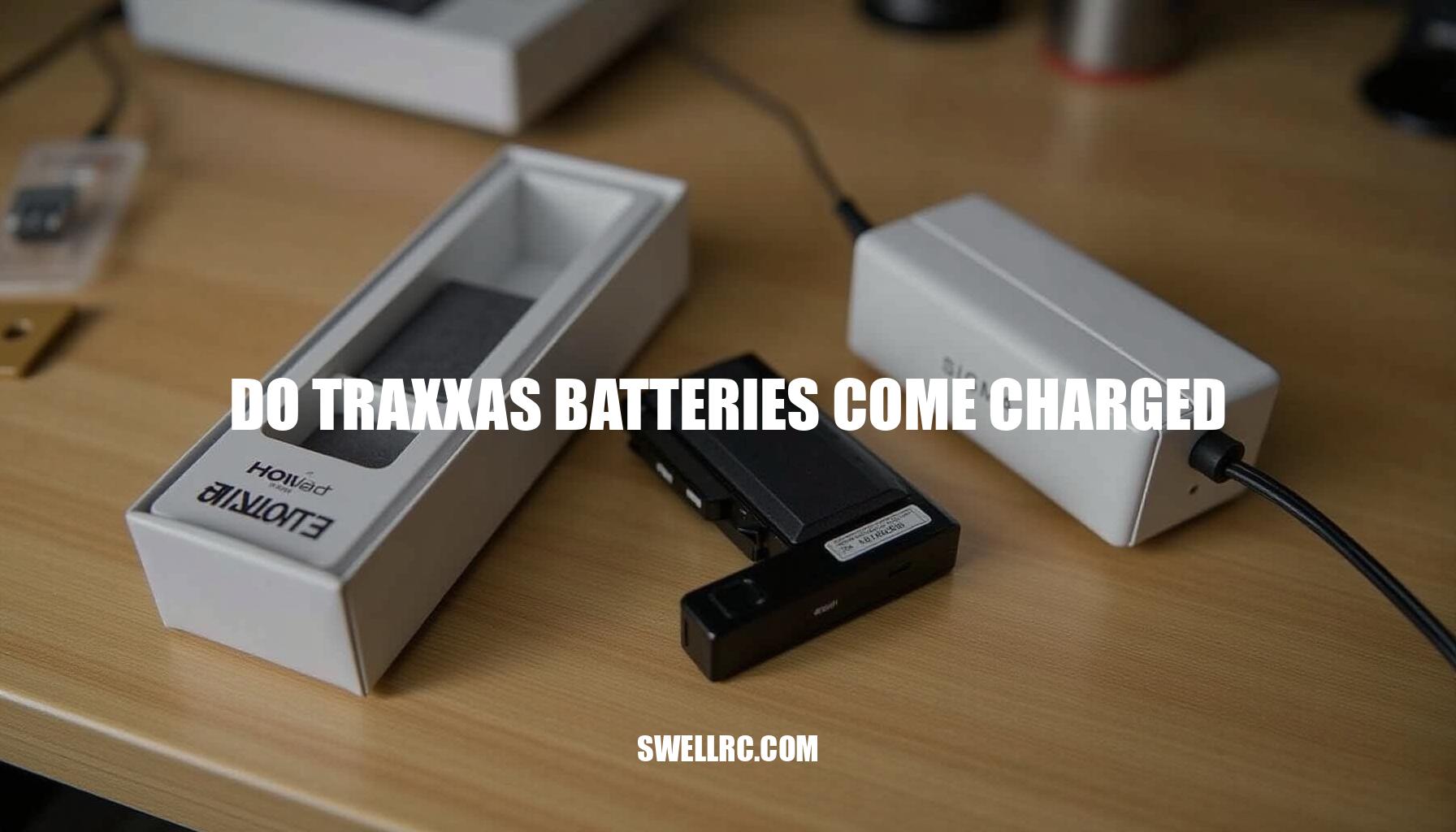Do Traxxas Batteries Come Charged from Factory?
When I first unboxed my Traxxas batteries, I was surprised to find they didn’t come fully charged. It’s a common question: Why don’t Traxxas batteries arrive ready to go? The truth is, LiPo packs typically ship at a storage charge level, around 3.7 to 3.85 volts per cell, which is roughly 30–60% state of charge. This LiPo storage voltage helps preserve battery health during shipping.
On the other hand, NiMH batteries may arrive partially charged but still need a full top-up before you hit the tracks. When I first connected my pack to the Traxxas iD charger—in my case, the Traxxas EZ-Peak Plus—I noticed the charger’s screen guiding me through an initial balance and charge cycle. This differs from my initial expectation that the battery would be fully primed right out of the box.
Manufacturers purposely avoid shipping batteries fully charged for safety reasons, including transport regulations, extending shelf life, and maintaining the chemistry’s health. In this article, I’ll walk you through what a proper first charge looks like with your Traxxas charger, share tips on RC battery safety, and cover essential advice for performance and long-term battery care.
Understanding Traxxas Battery Types and Their Charging Requirements
When comparing NiMH vs LiPo batteries, especially in the context of RC vehicles like those from Traxxas, it’s important to understand their differences in voltage behavior, weight, power delivery (or punch), care, and safety.
Voltage Behavior: NiMH cells have a nominal voltage of about 1.2V per cell and their voltage gradually drops during use, resulting in a modest performance curve. LiPo cells have a nominal voltage of 3.7V per cell and maintain a flatter voltage output until near depletion, offering stronger and consistent power, which translates to better punch.
Weight: LiPo batteries are much lighter than NiMH packs due to their chemistry and construction. This often means better handling and efficiency in your RC vehicle.
Punch (Power Delivery): Thanks to higher voltage and more consistent discharge, LiPo packs typically deliver sharper acceleration and sustained power compared to NiMH batteries.
Care and Safety: NiMH packs are more forgiving but need to be charged using NiMH mode with delta-peak detection to avoid overcharging and cell damage. LiPo batteries demand more careful handling—balance charging is essential, and charging must be done using the correct LiPo settings. Always avoid charging LiPo batteries in NiMH mode as this can cause dangerous overcharging.
Notably, Traxxas LiPo batteries often come preset to a storage voltage (~3.8V per cell). This means they need to be balance-charged up to a full charge of 4.20V per cell before running. NiMH batteries, by contrast, should be fully charged at their typical nominal voltage with delta-peak detection enabled.
Traxxas’ iD technology on batteries and chargers auto-detects the chemistry and cell count, making setup easier and reducing errors. Many chargers from Traxxas like the EZ-Peak Plus support this feature.
| Characteristic | NiMH | LiPo |
|---|---|---|
| Chemistry | Nickel-Metal Hydride | Lithium Polymer |
| Nominal Voltage per Cell | 1.2 V | 3.7 V |
| Typical Factory State-of-Charge | Fully charged (~1.4 V per cell) | Storage voltage (~3.8 V per cell) |
| Pros | Robust, safer, easier charging | Lightweight, high power, longer run time |
| Cons | Heavier, lower voltage output, memory effect (less so nowadays) | Requires careful charging, risk of fire if abused |
| First Charge Notes | Charge fully on NiMH mode with delta-peak detection | Balance-charge to 4.20 V per cell from storage voltage (~3.8 V per cell) |
| Safe Storage Target | Fully charged or fully discharged is fine for short term | Approximately 3.8V per cell (storage voltage) |
Speaking from experience, I once attempted charging a LiPo pack at a charge rate higher than the recommended 1C, thinking it would speed up the process. Not only did the charger alarm, but I learned the hard way about the importance of proper conditioning states and respecting the C-rate. Overcharging or fast charging can degrade battery life and increase risk.
That incident solidified my commitment to always balance-charge LiPos at safe rates and double-check charger settings.
For those using Traxxas chargers like EZ-Peak Plus, the Traxxas iD technology helps auto-set chemistry and cell count when paired with compatible batteries, which is a great way to reduce setup errors. However, if you’re charging non-Traxxas batteries, it’s essential to understand how to correctly adapt your charger settings. You can learn more about how to charge non‑Traxxas batteries on a Traxxas charger to avoid mistakes.
First-Charge and Maintenance Routine — Getting It Right from Day One
Charging your RC car battery correctly is essential for performance and longevity. Here’s a friendly, step-by-step guide to ensure a safe and effective charge, whether you’re working with LiPo or NiMH packs:
- Inspect the pack: Check for any damage, swelling, or punctures before charging.
- Connect the balance lead/iD plug: This ensures proper monitoring and helps your charger balance the cells effectively.
- Select the correct chemistry and mode: Choose LiPo balance-charge or NiMH charging mode depending on your battery type.
- Set the charge current to 1C: This means charging at a current equal to the battery’s capacity (e.g., 5A for a 5000 mAh pack), unless your manufacturer permits a higher rate.
- Place the pack in a LiPo-safe location: Safety first — use a fireproof bag or charging container.
- Monitor the temperature: During charging, keep an eye on the pack to prevent overheating.
- Wait for charger completion signal: It usually beeps or the LEDs indicate when charging is done.
- Verify cell balance (LiPo): Each cell should read about 4.20V for a full charge.
As a rule of thumb, charge duration follows this 1C charge rate principle; for example, charging a 5000 mAh pack at 5A takes about an hour. For deeper insights, check out our how long do I charge my RC car battery guide, and to understand battery lifespan, visit how long does a Traxxas battery last.
Detecting a full charge differs by chemistry: LiPo chargers signal with beeps or LEDs, and cells hit approximately 4.20V; NiMH packs end charge on a delta-peak drop and might feel slightly warm. Be cautious—avoid overcharging or leaving batteries fully charged for extended periods to maximize health.
Battery care directly ties into your vehicle’s tuning. Proper setup can optimize power use and performance—check out our tips on Traxxas speed control settings. Plus, linking your remote aids in battery monitoring and power management.
Learn how to link Traxxas TQ remote for smooth, efficient control.
With these steps, your RC car battery charging routine will be safe, efficient, and confidence-building — ready to power your next adventure!
Performance Insights and Recommended Upgrades
When evaluating runtime and throttle response on various Traxxas platforms, starting from a storage charge versus a true full charge makes a noticeable difference. With the compact fun of the Traxxas Mini Slash, beginning your session on a storage charge often results in reduced burst current, causing a slight lag in acceleration and an earlier onset of voltage sag. The car remains zippy, but peak punch is muted, especially on quick throttle inputs.
In contrast, a properly fully charged battery delivers snappiness and consistent throttle feel, crucial for the lively performance this model is known for.
On the trail with the Traxxas Jeep, battery readiness impacts not only runtime but trail consistency. Starting from storage charge may reduce usable run time by up to 15%, and voltage sag under load becomes more pronounced, slightly dulling throttle sensitivity on rugged climbs. True full charges maximize available capacity and minimize internal resistance effects, ensuring the Jeep powers steadily through terrain without unexpected throttle dips.
Comparing these electric models to Traxxas gas-powered RC cars reveals a different fueling mindset. Gas vehicles offer instant throttle response with a full tank, but managing fuel differs from the electrical discipline needed in LiPo or NiMH packs. Proper charging and maintenance of electric batteries influence performance much like the quality and readiness of gas affects nitro engines, though electrical systems demand consistent voltage and minimal internal resistance for optimal output.
Correct charging techniques enhance your battery’s ability to deliver higher burst current, translating directly to improved acceleration and extended runtime. To further elevate your driving experience, consider these upgrade paths:
- Higher-capacity packs within spec: Upgrading battery capacity increases runtime without stressing ESC and motor components.
- Low-internal-resistance (IR) packs: These reduce voltage sag and improve throttle response during high current draws.
- Faster smart chargers: Efficiently restore full charge more quickly, minimizing downtime and preventing partial charges that degrade performance.
For those interested in learning how to upgrade an RC car battery, you’ll find detailed guidance to balance upgrades with your setup’s capabilities. Newcomers looking for budget-friendly entry points for thrilling electric experiences can explore Traxxas RC cars under $100, which tend to offer robust performance to learn about runtime optimization and throttle nuance without heavy investment.
Bullet Summary of Upgrade Options and Real-World Impact:
- Capacity upgrades increase runtime without sacrificing throttle feel.
- Low-IR batteries reduce voltage sag under heavy load, improving acceleration sharpness.
- Faster chargers maintain battery health and readiness, optimizing performance every session.
- Starting from a true full charge significantly enhances burst current and throttle response compared to storage charge.
- Budget-friendly platforms like the Traxxas Mini Slash offer excellent arenas to experience these differences firsthand.
Safety, Storage, and Longevity Best Practices
Keeping your battery packs in top shape doesn’t have to be complicated! When it comes to LiPo safety, remember that storing your LiPo batteries at around 3.8V per cell is ideal to maintain longevity. For NiMH packs, aim for about 50–70% charge before storage to prevent capacity loss.
Most Traxxas chargers have a handy Storage Mode that automatically discharges or charges your pack to these safe voltages — a real lifesaver in storage mode management.
Here are some easy-to-remember rules to keep your batteries healthy:
- Always store batteries in a cool, dry place within a temperature range of 10–25°C (50–77°F), away from flammable materials and direct sunlight.
- Never leave charging batteries unattended; always use the correct charging mode for your battery type.
- Don’t use or keep puffed or physically damaged packs; signs like swelling, increased internal resistance, cells drifting more than ~0.02–0.05V apart, or reduced runtime signal the need for reconditioning or replacement.
- After running your batteries, allow them to cool gently before charging to help prolong battery life.
- For LiPos, never discharge below the ESC’s low-voltage cutoff to prevent irreversible damage.
- Schedule periodic health checks by measuring cell voltages and internal resistance to spot issues early.
A personal tip: I once left a fully charged LiPo sitting unused for a week and noticed a noticeable drop in performance afterward. That experience taught me how crucial proper storage voltage and timing are for battery health.
Following these friendly, actionable guidelines will ensure your batteries stay safe and last longer, keeping your RC adventures powered and worry-free!
Conclusion — Charging Smarter for Maximum Fun
Key Takeaway: Traxxas batteries do not arrive fully charged from the manufacturer; LiPo batteries ship at storage voltage and NiMH packs require a top-up charge before your first drive. Understanding this distinction between full charge vs storage charge is essential for optimal battery care and performance. To keep your packs healthy and ensure safe operation, it’s best to follow best charging practices consistently.
Whenever possible, use iD-compatible chargers designed specifically for Traxxas batteries — this improves charger compatibility and simplifies the process of monitoring cell health and balance.
From my own experience, dialing in the right charging routine transformed my RC sessions: I noticed more punch, longer run times, and less worry about pack longevity. It’s amazing what proper attention to Traxxas battery storage and charging can do for your RC driving performance. Here are a few friendly reminders to help you get started:
- Always check the voltage before using or charging your battery pack.
- Charge LiPo batteries to storage voltage when not in use for extended periods.
- Top-up NiMH batteries before each session to maintain peak performance.
- Use chargers compatible with Traxxas iD batteries to ensure correct charging profiles.
- Regularly monitor battery health and replace cells when needed to avoid surprises.
Remember, experimenting responsibly with your setup and charging habits while keeping an eye on voltage levels will help you enjoy the hobby confidently and safely. Embrace the learning curve and watch your RC driving performance soar!
Frequently Asked Questions
- Do Traxxas batteries come pre-charged from the factory?
No. Traxxas LiPo packs typically ship at storage voltage (~3.7–3.85V per cell, about 30–60% charged) for safety and longevity. NiMH packs may have a small residual charge but should be fully charged before first use. - How long should you charge a Traxxas battery before the first use?
It depends on capacity and charge rate. At 1C, a 5000 mAh pack charged at 5A takes roughly 60–75 minutes. Use the correct mode—balance charge LiPos to 4.20V per cell, and let NiMH finish on delta‑peak detection. - What is the best way to store Traxxas batteries?
Store LiPos at storage voltage (~3.8V per cell) in a cool, dry place (about 10–25°C/50–77°F). Store NiMH around 50–70% charged and top up every few months. Avoid storing packs fully charged or fully depleted. - Can you use a non-Traxxas charger for Traxxas batteries?
Yes, if it supports the correct chemistry (LiPo/NiMH), balance charging for LiPos, and appropriate current limits. You may need iD adapters. When in doubt, use a Traxxas iD‑compatible charger and follow the manual. - How can you tell if your Traxxas battery is healthy?
Healthy packs hold voltage under load, deliver expected runtime, and (for LiPos) have cells within ~0.02–0.05V of each other with no swelling. Internal resistance should be stable over time; NiMH should not overheat in normal use. - What happens if you overcharge a Traxxas battery?
Overcharging LiPos can cause swelling, venting, or fire; overcharging NiMH can overheat and vent. Always use the correct charger and mode, balance‑charge LiPos, and never exceed 4.20V per cell.



